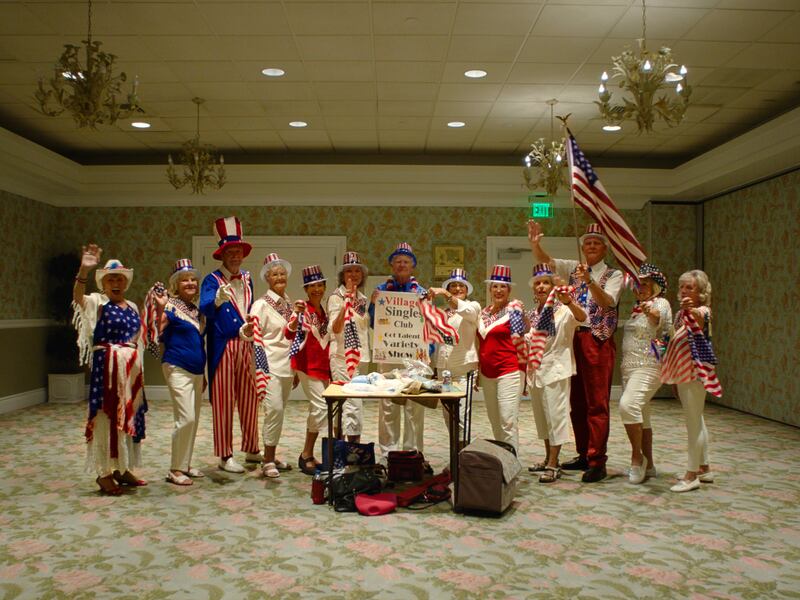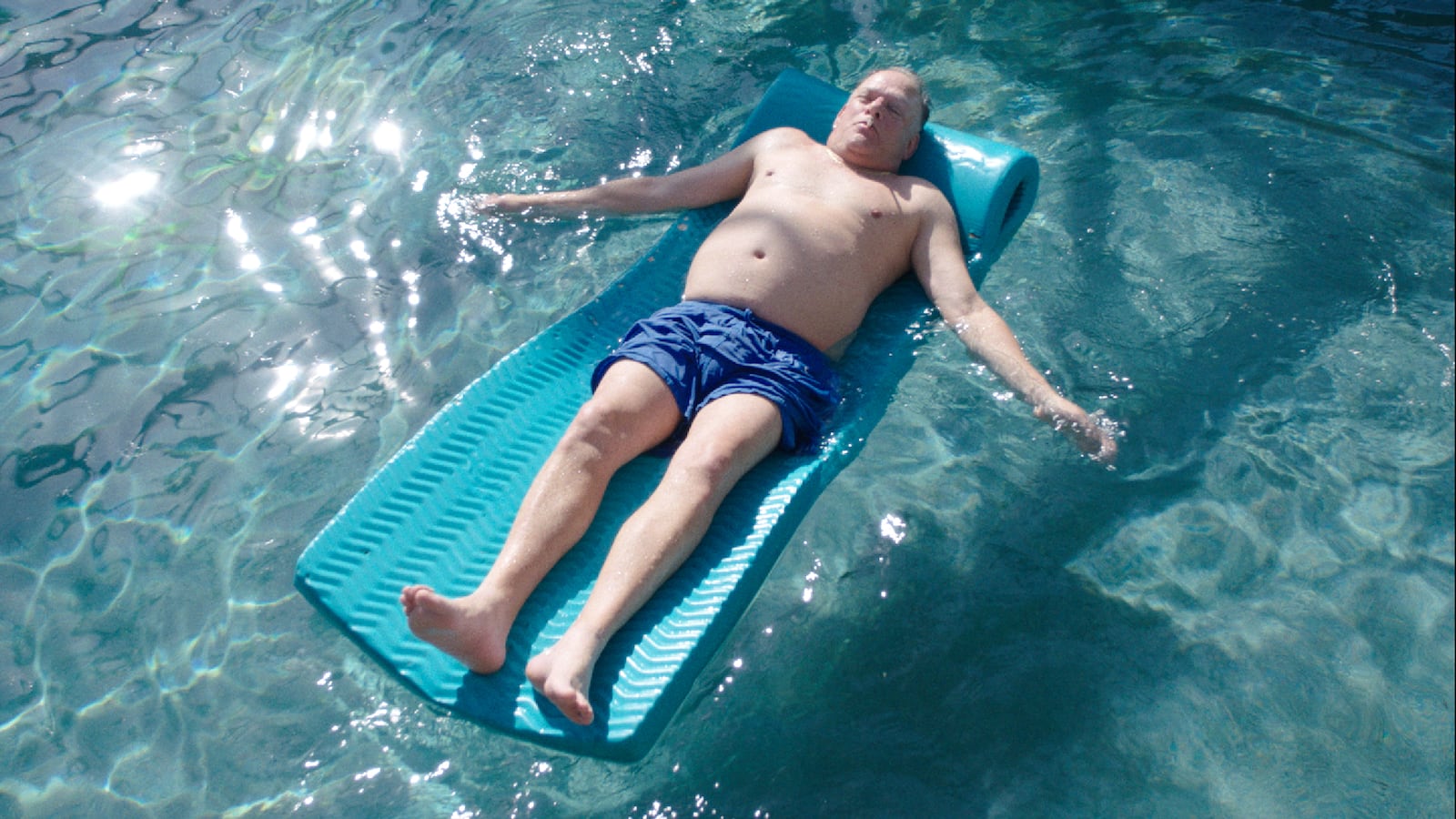When Spanish conquistador Juan Ponce de León set out to find the fabled Fountain of Youth, legend has it that he sailed through Lake Sumter in Central Florida, guided by a historic lighthouse that today stands in America’s largest retirement community: The Villages.
Legend according to The Villages, at least—never mind the fact that the retirement community’s developer built the man-made Lake Sumter and its lighthouse in the late-20th century with help from a team of set designers from Universal Studios.
It is tall tales like this that give The Villages its sheen of magical realism and initially caught my eye as a documentary filmmaker. Behind the gates of “Florida’s Friendliest Hometown,” over 130,000 residents age 55 and up inhabit an artificially constructed world full of facades, both architectural and intellectual. Supported by an in-house television news operation that omits negative stories, a radio station that plays nothing but oldies, and an aura of relentless positivity grounded in 1950s American idealism, the allure of the so-called “active Villages lifestyle” has turned this geritopia into one of America’s fastest-growing cities. While COVID-19 continues to ravage elderly communities, many Villagers continue to participate in golf-cart parades, pickleball tournaments, and tiki cocktail hours, their nostalgia apparently strong enough to block out even the grimmest reality.

The Villages fascinated me from a young age. Growing up in a South Florida neighborhood flanked by retirement communities, I encountered my fair share of snowbird retirees—but The Villages was something else. Despite living several hours away from the development, tall, salacious tales from this self-dubbed “Disney World for Retirees” seeped its way into my local newspaper. Chief among them: the community’s infamously high rate of STD transmission. Naturally, local news turned the place into a raunchy punchline. As I grew up, though, I came to sense that a more interesting story was being obscured. Here, in Central Florida, was an entire city of folks who had chosen to secede from everyday society and embrace an alternate reality: a real-life Truman Show fantasy designed to simulate everlasting youth.
After stumbling across a Villages promotional video that advertised surreal suburban bliss (“Free golf for the rest of your life!”), and looked like it was strung together from the outtakes of the opening to David Lynch’s Blue Velvet and Ronald Reagan’s Morning in America ad, I knew I had to visit. While recent coverage of the notoriously homogenous community—98.2% of its residents are white—has focused on its reputation as a conservative bastion with white-supremacist undertones, I wanted to tell a story that went a level deeper and interrogated the underlying fantasy that draws so many people to this palm-fringed echo chamber. The film needed to go beyond partisan politics and speak to a more fundamental facet of the place: the absurd lengths to which many Americans go, especially later in life, to live out their fantasies. In the summer of 2018, as I approached my senior year of college, I packed my bags and embedded myself in the social fabric of retirement mecca.
I spent my first month in The Villages renting a room from longtime Villagers Mary and Donald Fortier, a pair of retired rodeo clowns who quickly became my unofficial tour guides. With the generous help of my new hosts, I did my best to live the local lifestyle. Mary and Donald filled my schedule with shuffleboard, pickleball, Zumba, and visits to club after club. Eventually, I learned that Mary was undergoing treatment for a terminal illness. It was in this couple’s steadfast commitment to the Villages lifestyle despite the specter of death that I began to sense this artificial place’s very real life-affirming power. I realized at this moment that I was not making a film about elderly people, but one about people.
Despite being three generations removed from the typical Villager, I was surprised to find the pursuits and struggles of most people I met instantly relatable. Their attempts to turn back the clock in search of love, solace, and youth rhymed with my own bout of college-graduation-induced Peter Pan Syndrome. The romantics I met at the singles club spoke of familiar trysts; one Villager’s, shall we say, substance-enhanced transcendental meditation practice resembled my occasional attempts to escape to another world. In a matter of weeks, the generational gap entirely disappeared—at least in my mind—and I found myself sympathizing with the loners and troubled folks whose stories seemed at odds with the ethos of the place.
WATCH A SCENE FROM ‘SOME KIND OF HEAVEN’:
One of these people, Barbara Lochiatto, is the subject of this featured clip from the film. Barbara was reluctant to move from Boston to The Villages in the first place; ultimately, she did so only at the urging of her husband. After his death, tragically, she found herself trapped in would-be paradise: she desperately wanted to leave the place that did nothing but amplify her loss, but she lacked the financial means to do so. As a widow, she found herself working a part-time job to sustain a retirement lifestyle she never sought to begin with. Trapped in a cycle of grief and loneliness, Barbara found herself cooped up at home day after day.
In this clip, one of my favorite moments in the film, we see Barbara recount her first foray back into the dating scene to her hairdresser. She revels in the surprising chemistry she felt with a man named Lynn, a charismatic golf cart salesman we meet at another point in the film. This heart-to-heart conversation is a small victory for Barbara, a glimmer of optimism that lifts her depression and restores a bit of The Villages’ fantasy.
It is my hope that this scene speaks to the idea that even in life’s final chapters, our most youthful desires persist and the search for fulfillment never quite ends. By and large, the friends I made in The Villages are working through the same problems I’m experiencing in my twenties. In that sense, I suppose, they have found eternal youth.
Some Kind of Heaven is now available to rent on Prime

